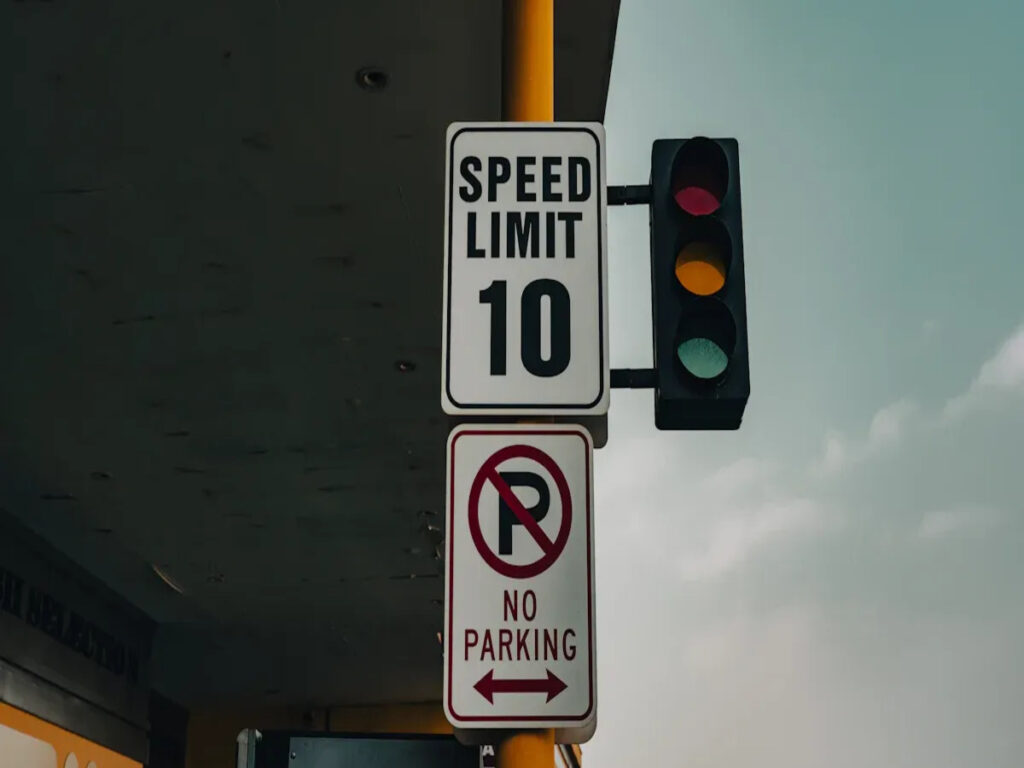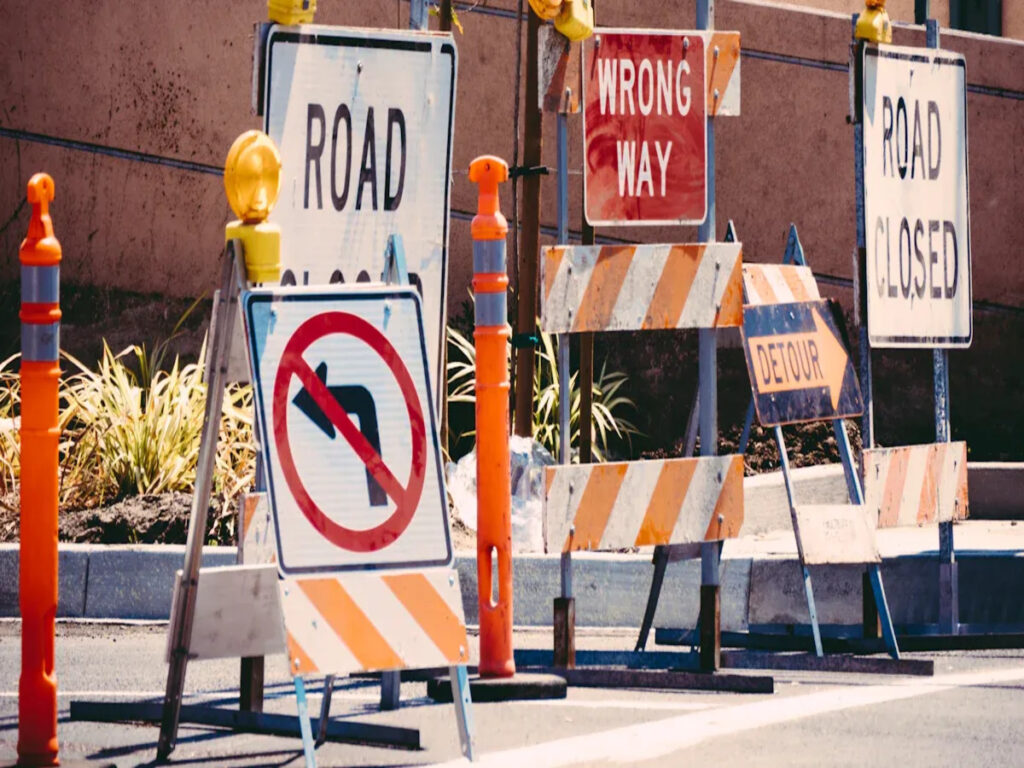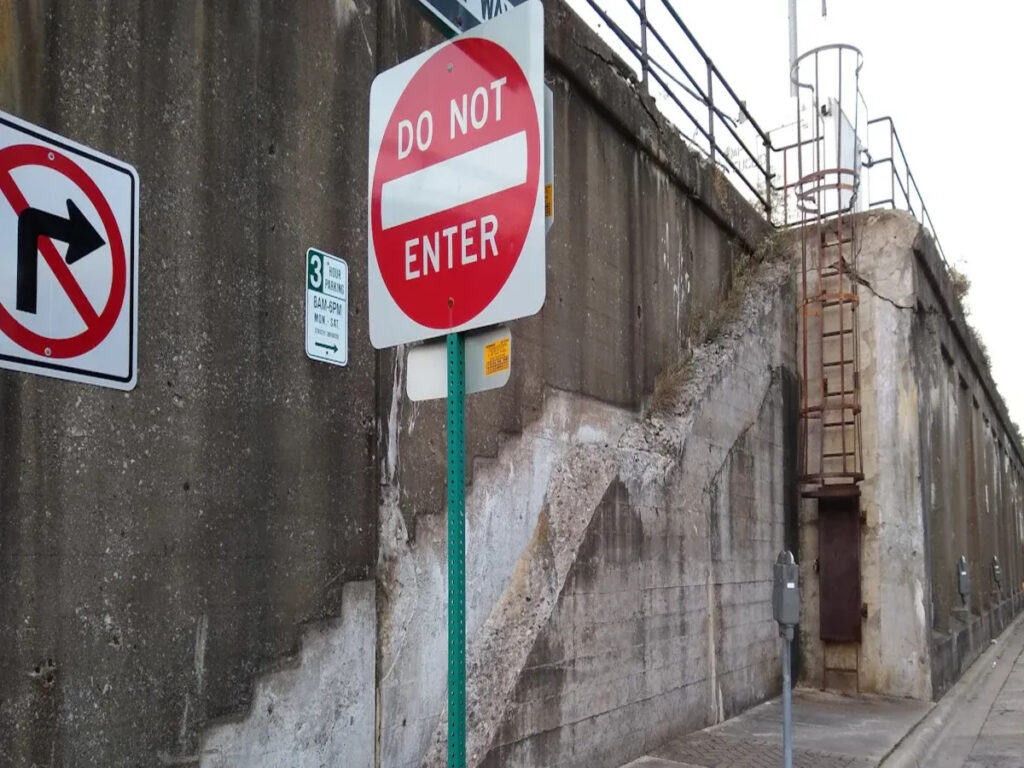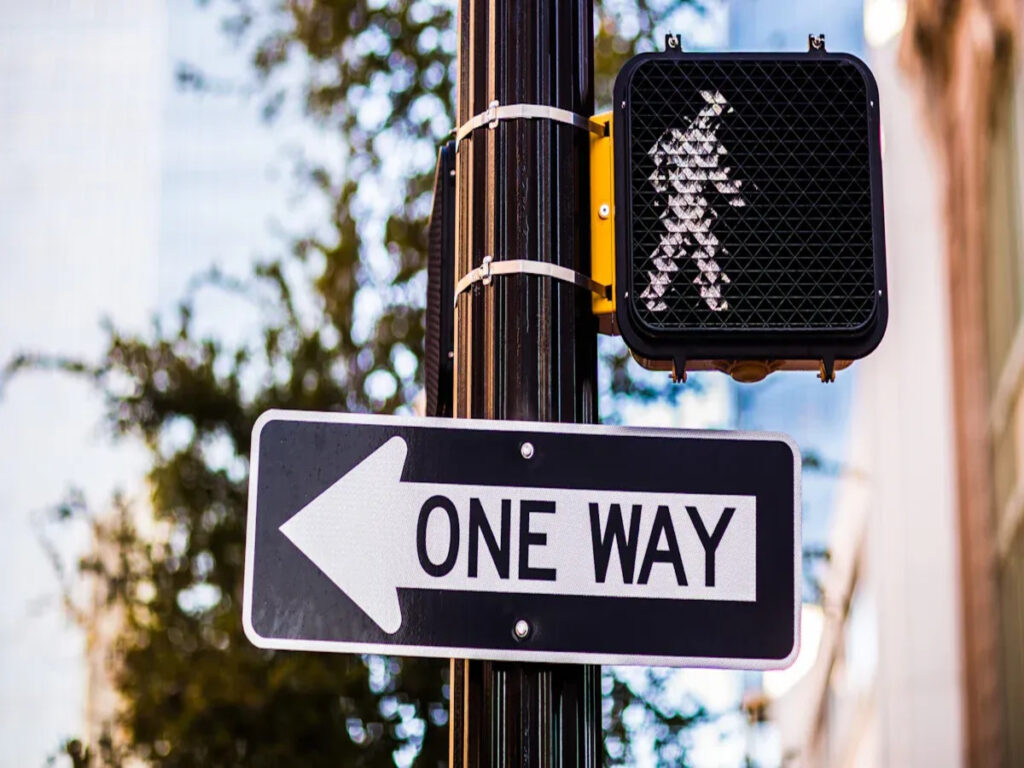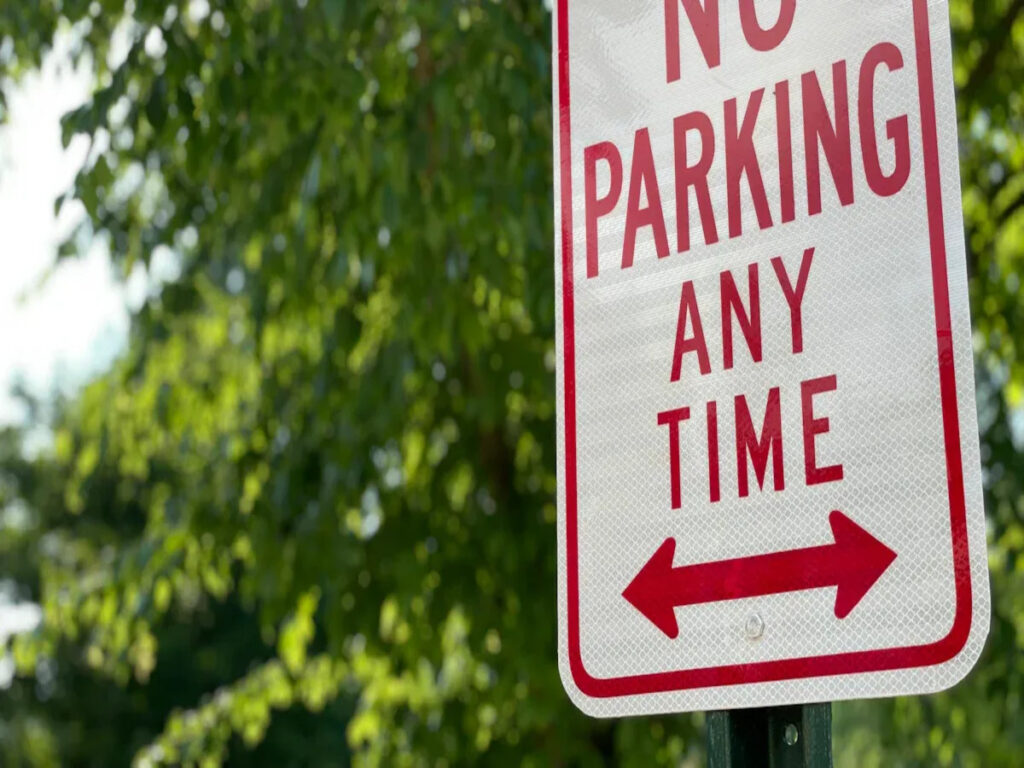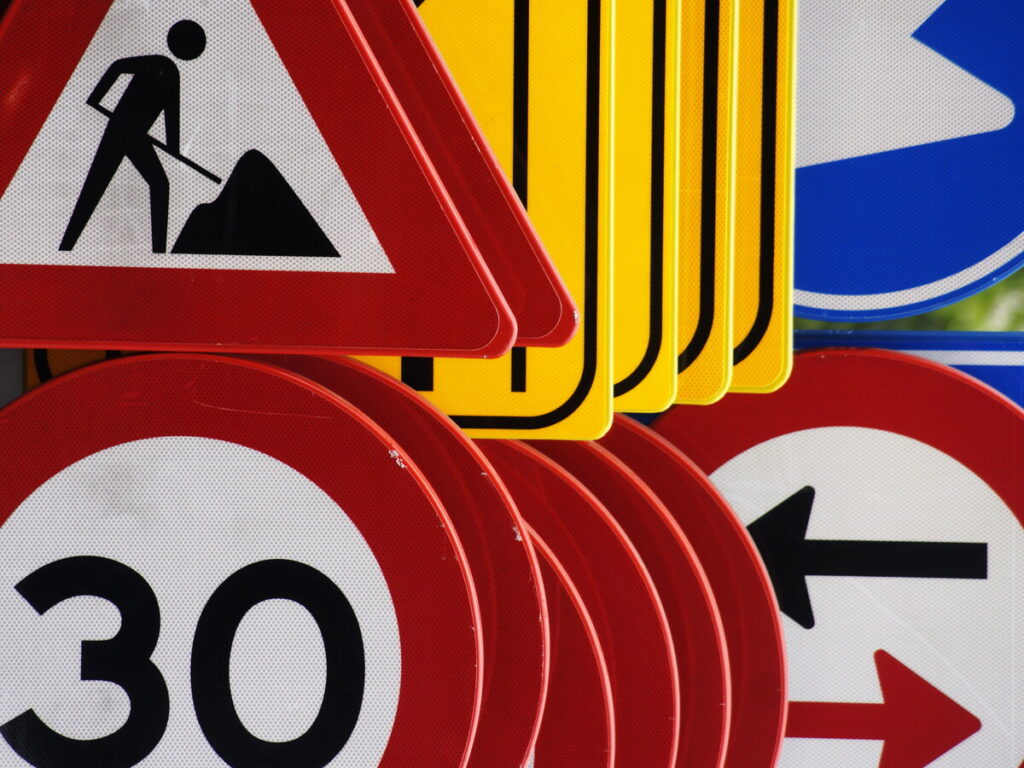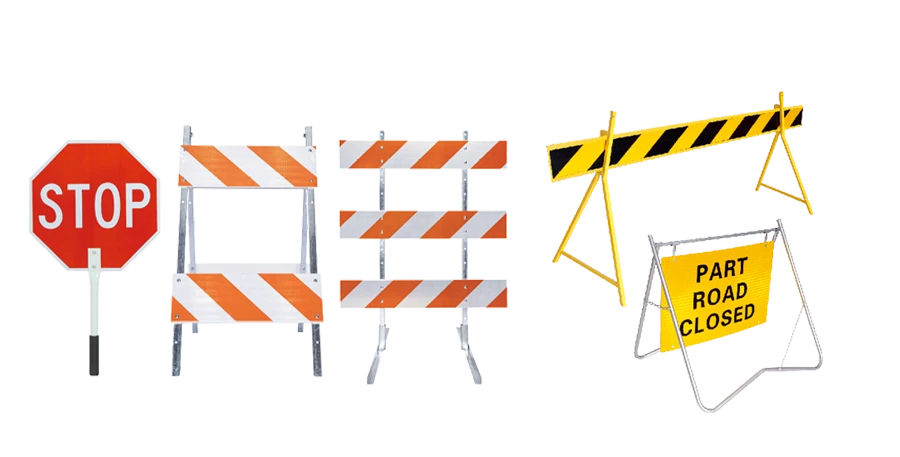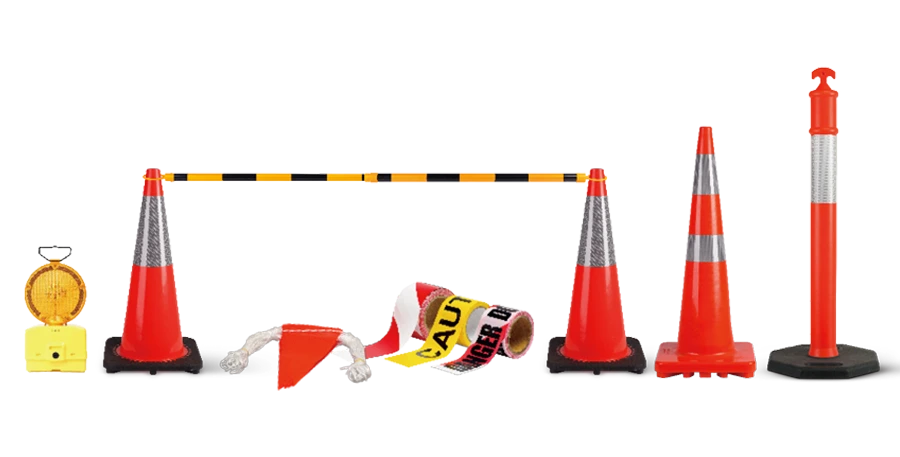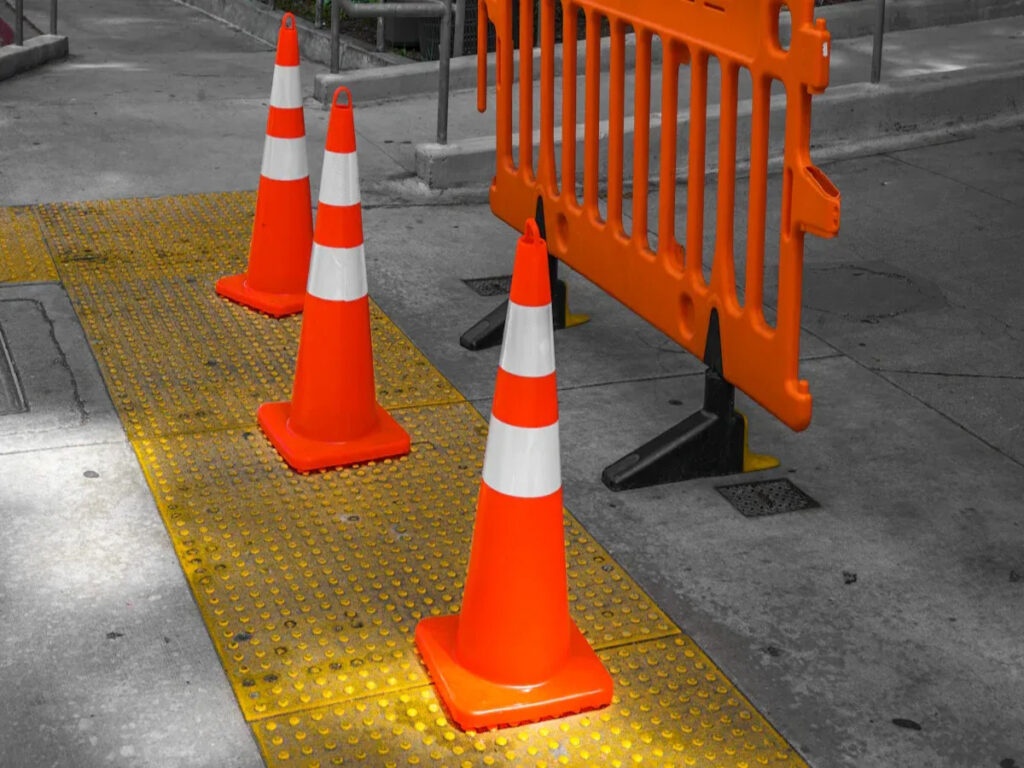
When you pick barricades for closing a road, you want them to be easy to see and last a long time. Type III barricades are special because they have advanced sheeting. This sheeting works well at night, especially on flat roads. Tests show drivers can see these barricades from farther away than other types. You should always think about safety, how easy it is to set up, and the price when you look at traffic barricades for sale. Make sure your choice matches your needs and follows local rules.
Optrafficのオファー Type III barricades designed with high-quality reflective sheeting to ensure excellent visibility, 低照度条件でも. These barricades are built for long-term durability, easy installation, and compliance with safety standards. Browse through our collection to find the perfect traffic barriers that meet your needs and keep roadways secure.
キーテイクアウト
- Type III barricades are easy to see and very strong. They are best for closing whole roads. They work well for big projects and busy streets.
- Pick barricades by looking at your project’s size and how much traffic there is. Think about safety needs too. This helps you follow local rules.
- Water-filled and concrete barricades are very strong. They are good for long projects. Water-filled ones are easier to move when empty.
- Lighter barricades like A-Frame, タイプI, and Type II are good for small jobs. They work for short closures or places with little traffic.
- Always make sure barricades are bright and reflective. They should meet safety rules. This keeps drivers and workers safe all day and night.
Types of Barricades
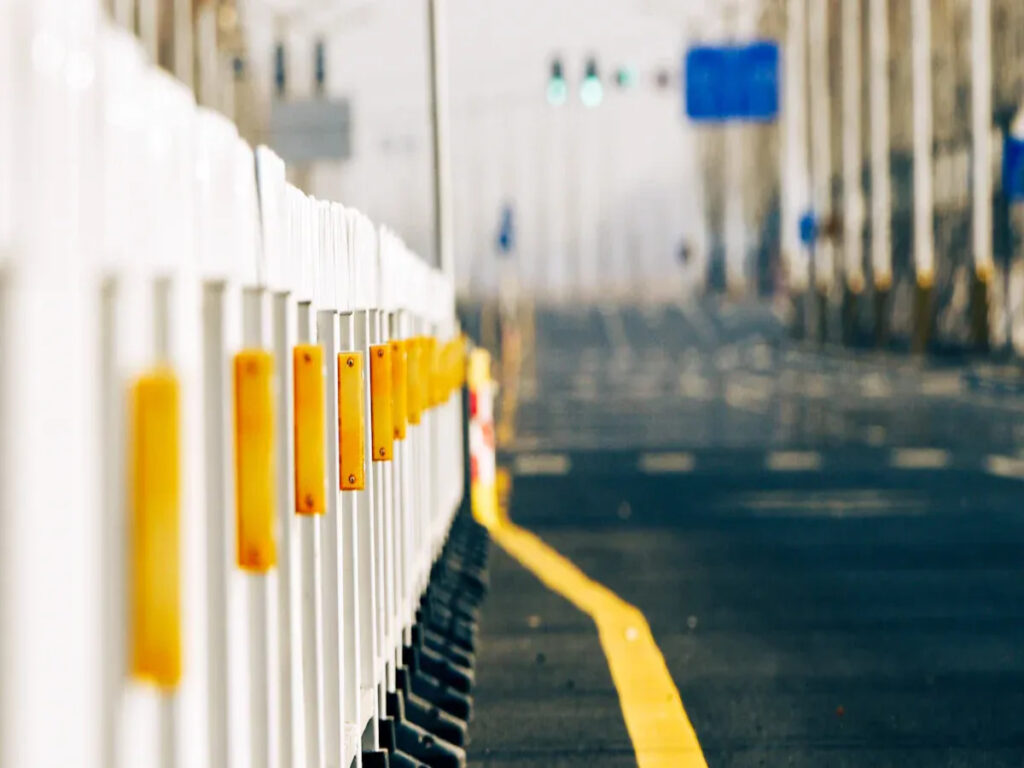
A-Frame
A-Frame barricades are good for small jobs and events. You can fold them and carry them without trouble. Most A-Frame barricades are made from plastic or metal. They have reflective strips or lights to help people see them at night. These barricades help control crowds and block off small spots. You can use them in parking lots, on sidewalks, or at events. Local rules say you must put them in the right place and keep them in good shape.
タイプI
Type I barricades have one reflective rail. You see them near small hazards like manholes or potholes. They are light and simple to move. You should not use them for closing whole roads or on fast roads. They work best for parking lots, sidewalk repairs, or as simple barriers. Type I barricades must follow MUTCD rules for size and reflectivity.
Type II
Type II barricades look like Type I but have two reflective rails. This makes them easier to see, even at night or in busy places. You can use them for medium road work, daytime jobs, or city streets. They fold up so you can move them easily. Type II barricades also follow safety rules.
タイプIII
Type III barricades are the biggest and easiest to see. They have three reflective rails on each side. You should use them for big road closures, highway work, or long jobs. These barricades are the most stable and visible of all types. They come in many lengths and use strong materials like steel, ゴム, またはプラスチック. Type III barricades meet strict safety rules and work well in tough spots.
ヒント: Type III barricades give you the best protection and are easiest to see for big road closures.
Water-Filled
Water-filled barricades are bright and can hold water or sand for weight. When empty, you can move them without much effort. 満たされたら, they become strong barriers for traffic. They absorb crashes better than concrete, which helps keep people safe. You can use them for short or long projects. Some water-filled barricades let you add fencing or signs.
コンクリート
Concrete barricades last a long time and do not need much care. You see them on highways or where you need strong barriers. They do not move easily, so they are good for long road closures. Snow and weather can change how long they last, but they need fewer repairs than other barricades.
Metal
Metal barricades, usually made of steel, help control crowds and work zones. You can use them at events, 建設現場, or as barriers for traffic. 彼らは簡単に曲がったり壊れたりしません, 悪天候でも. Metal barricades last a long time and are easy to move and set up.
Traffic Barricades for Sale: Comparison
効果
When you look for traffic barricades for sale, you want to know which ones work best to stop or guide cars. Type III barricades are easy to spot because they block the whole road with three wide rails. These rails make them strong and hard to move. They keep cars out of closed areas. Water-filled barriers also work well, especially when filled with water or sand. They can take a hit and help protect drivers and workers. Concrete barriers are heavy and hard to move, so they are good for long jobs. A-Frame, タイプI, and Type II barricades are better for small jobs or places with less traffic. Metal barricades help control crowds but do not stop cars as well as other types.
注記: For big road closures, pick Type III barricades or water-filled barriers for the best results.
可視性
Drivers need to see traffic control devices from far away, 夜や悪天候でも. OSHA rules say barricades must have bright colors and reflective stripes. Type III barricades have three reflective panels, so they are the easiest to see. Type II barricades have two panels, which helps drivers see them. Type I barricades have one panel, so they are not as bright. Water-filled and A-Frame barricades use orange and white stripes and can have lights for extra safety. Concrete barriers sometimes have reflective tape, but you need to check that it stays clean and bright.
Here is a table that shows how different barricades compare for visibility:
| Barricade Type | 反射機能 | Visibility Enhancements |
|---|---|---|
| タイプI | Single reflective panel, orange and white stripes | Basic reflective sheeting |
| Type II | Two reflective panels | More surface area for better visibility |
| タイプIII | Three reflective panels, largest size | Maximum visibility for road closures |
| Water-Filled | 明るい色, can add lights or signs | 高い視認性, especially when filled |
| コンクリート | May have reflective tape | Needs regular cleaning for best results |
| A-Frame | Reflective patterns, can add lights | Good for small areas and events |
| Metal | Sometimes painted or with reflectors | Best for crowd control, not for roads |
Check reflective surfaces often to keep them clean and bright so drivers always see the barricades.
耐久性
Durability is important when you pick traffic barricades for sale. Type III barricades use strong materials like steel or heavy-duty plastic. They last through rain, 風, そして太陽. Concrete barriers last the longest and need little care. Water-filled barriers can handle weather but may need refilling if they leak. Metal barricades do not bend or break easily, but they can rust if left outside for a long time. A-Frame, タイプI, and Type II barricades are good for short jobs but may wear out faster if used every day.
ヒント: For long projects, concrete and Type III barricades give you the best durability.
Deployment
Setting up traffic barriers can take a long time or just a few minutes, depending on the type. Lighter barricades like A-Frame, タイプI, and Type II are easy to carry and set up. One or two people can move them. Type III barricades come in bigger pieces, but a small team can set them up fast. Water-filled barriers are light when empty, but you must fill them with water or sand after placing them. Concrete barriers need heavy machines and more workers, so setup takes much longer.
Here is a table that shows how long it takes to set up each type and how many people you need:
| Barricade Type | Deployment Time | Labor Requirements | Notes on Use |
|---|---|---|---|
| Concrete Barrier | Many hours | Heavy equipment, several workers | Best for long-term, high-security projects |
| Water-Filled Barrier | 素早い (空のとき) | Few people, fill after placement | Good for short or long-term use |
| Type III Barricade | Fast | Small team, lightweight setup | Great for detours and road closures |
| Type I/II/A-Frame | Very fast | One or two people | Best for small jobs or events |
| Metal Barricade | Fast | One or two people | Used for crowd control, not for cars |
Plan your setup based on how many workers and tools you have.
料金
Cost is a big thing to think about when you look at traffic barricades for sale. Concrete barriers cost more at first, but they last a long time and need little care. Water-filled barriers cost less to buy and move, but you may need to refill or fix them. Type III barricades cost more than Type I or II, but they give you better safety and last longer. Metal and A-Frame barricades cost less, but they do not work for every job.
Here is a chart that compares maintenance and traffic delay costs for different traffic barriers:
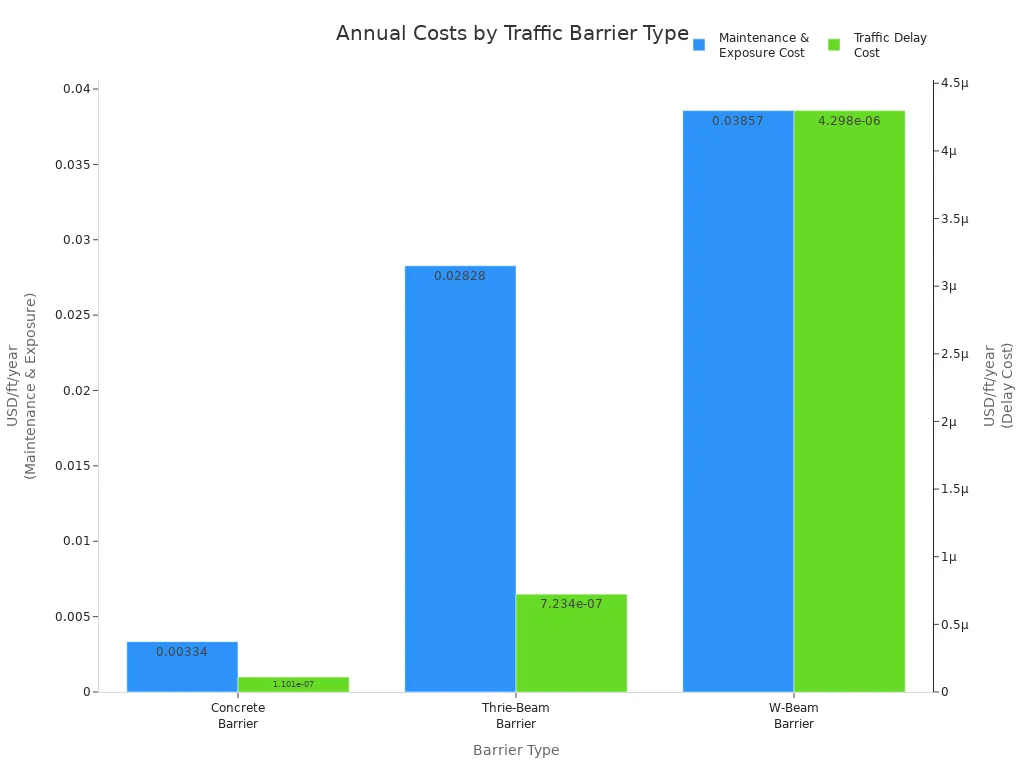
Concrete barriers have the lowest maintenance and delay costs. Thrie-beam and W-beam barriers cost more to keep up. When you choose traffic control devices, think about both the price to buy and the cost to keep them working.
注記: Type III barricades give you the best mix of visibility and durability for most road closures, especially on highways and busy roads. When you shop for traffic barricades for sale, match your choice to your project’s needs and your budget.
Strengths & Weaknesses
A-Frame
A-Frame barricades are light and easy to carry. You can set them up fast for small jobs or events. They fold up, so you can store and move them easily. These barricades work well for crowd control in parking lots or on sidewalks. But they are not very stable in strong wind or heavy traffic. Drivers might not see them well at night unless you add lights or more reflectors.
タイプI
Type I barricades are simple and do not cost much. You can use them for small roadwork or to mark hazards. They have one reflective panel to help drivers see them. But they are not as bright as bigger barricades. They are easy to move and set up. まだ, they are not strong or bright enough for busy roads or long closures.
Type II
Type II barricades have two reflective rails, so they are easier to see. This makes them stand out more than Type I barricades. They are bigger and heavier, so they stay in place better. You can use them on busy roads and highways. They work well where cars go fast. They are smaller than Type III barricades but still work well for many road jobs.
ヒント: Type II barricades are a good pick for medium jobs because they are easy to see and stay in place.
タイプIII
Type III barricades are the easiest to see and the strongest. You see them most at full road closures or highway work. They have three reflective rails, so drivers spot them from far away. They use strong materials and last through bad weather and lots of use. You may need a small team to set them up, but they give the best safety for big jobs.
Water-Filled
Water-filled barricades are bright and easy to move when empty. You can fill them with water or sand to make them heavier. They take hits better than concrete, which helps keep people safe. You can use them for short or long projects. You can add signs or fencing to them. But you must check for leaks and refill them if needed.
コンクリート
Concrete barricades are strong and last a long time. You often see them on highways or in risky places. They are heavy and hard to move, so you need special machines to set them up. This makes them less useful for short road closures. Drivers may not see them as well as plastic barricades, 特に夜に. Concrete barriers can be more dangerous in crashes and may have problems at the joints if damaged.
Metal
Metal barricades help control crowds at events or work sites. They are heavy, so people cannot steal them easily. You can use them to block off areas or for crowd control. But metal barricades can rust, bend, or break, especially at the feet. You may need to fix or replace parts often, より多くの費用がかかります. Plastic traffic barriers usually last longer outside and need less care.
Best Use Cases for Barricades
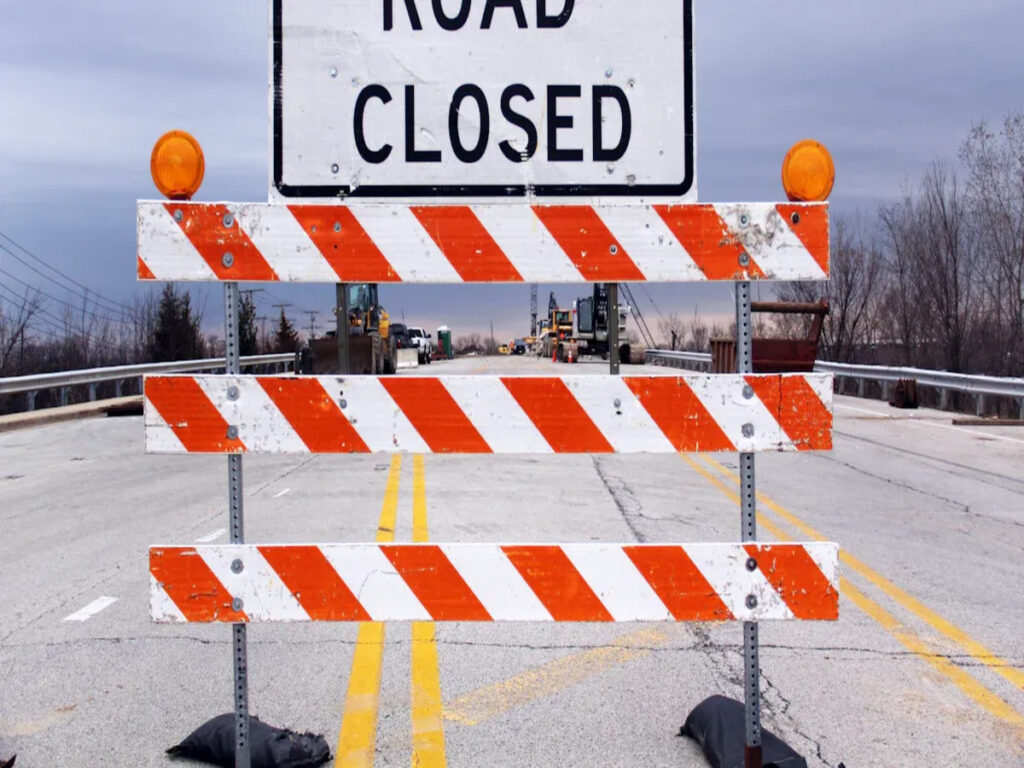
Short-Term Closures
時々, roads need to close for a short time. タイプI, Type II, and Type III barricades work well for this. Type I and II are light and simple to move. You can use them where cars still drive by, like city streets or small repairs. Type III barricades are best if you must block the whole road, even for a little while. These have three reflective rails, so drivers see them from far away. The table below shows which barricade fits each short-term job:
| Barricade Type | Recommended Use | 重要な機能 | メモ |
|---|---|---|---|
| タイプI | Traffic keeps moving | One reflective rail | Not for full closures |
| Type II | Faster roads | Two reflective rails | Good for guiding cars |
| タイプIII | Full or part closures | Three reflective rails | Best for short closures |
Have someone check the barricades during the closure to keep people safe.
Long-Term Closures
Long projects need strong and easy-to-see barricades. Water-filled barricades stand out because you can fill them with water or sand. This makes them heavy and hard to move. They work well for many months. Concrete barriers, also called Jersey barriers, give strong protection for highway work. Type III barricades also help with long jobs because they are big and easy to spot. Pick the right barricade for how long your project lasts and how much safety you need.
High-Traffic Areas
Busy roads need the safest and brightest barricades. Type III barricades are the biggest and have three reflective rails. You can use them to close roads or guide cars in crowded places. Water-filled barriers help too because they are bright and take hits well. Channelizer drums and cones help guide cars through work zones. Concrete barriers are best for long, busy projects. Always use reflective strips and lights so drivers see the barricades at night or in bad weather.
| Barricade Type | Safety Benefits | Best Use in High-Traffic Areas |
|---|---|---|
| タイプIII | Easy to see, 強い | Road closures, 迂回 |
| Water-Filled | Absorbs hits, 明るい色 | 一時的な交通規制 |
| コンクリート | とても強い, stays in place | Long construction zones |
Emergency Closures
緊急事態, you need to act fast. Type III barricades help you close roads quickly and clearly. Their size and three reflective panels make them easy to see, 遠くからでも. You can also use Type I and II barricades for smaller emergencies or slow roads. Traffic cones and barrels work for very short times, but they do not stop cars as well as other barricades. Water-filled barriers add strength if you need a tougher barrier fast.
都市対. 田舎
Barricade needs are different in cities and the countryside. City roads usually have lower speed limits, so you can use shorter cones and put signs closer to the work. Country roads have higher speeds, so you need taller cones and put signs farther away. The chart below shows how these needs change:
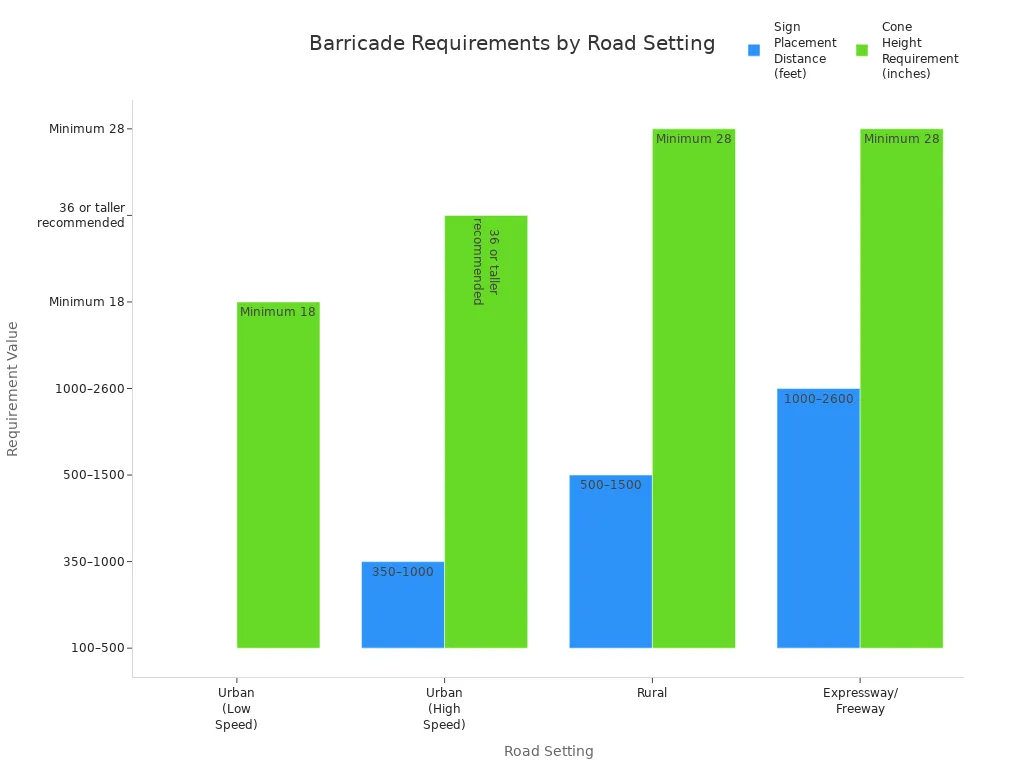
Always match your barricades to the road’s speed and location. This helps drivers react in time and keeps everyone safe.
Buying Barricades: ヒント & 推奨事項
Top Choice for Road Closures
If you need to close a road, Type III barricades are the best pick. They have three wide rails with orange and white stripes. These rails use special reflective sheeting that shines at night. The strong build can be wood, 金属, or tough plastic. Type III barricades follow all MUTCDルール. You can put them across the whole road to block cars. They often have “ROAD CLOSED” signs that are easy to read. You can add flashing lights or flags for extra safety in the dark or rain. Sandbags or other weights keep them from falling over in wind or if bumped. Type III barricades work for many jobs, like construction, emergencies, or long-term closures.
Here is a table that shows why Type III barricades are the best:
| Key Factor | 説明 |
|---|---|
| デザイン | Three rails with bright, reflective stripes for high visibility |
| 材料 | Strong wood, 金属, or plastic for long-lasting use |
| コンプライアンス | Meets MUTCD and other safety standards |
| 配置 | Covers the whole road or lane, with clear signage |
| Enhancements | Can add lights or flags for better visibility |
| 安定性 | Uses sandbags or weights to stay in place |
| 安全性 | Keeps emergency access and walkways clear; stays visible and strong with regular checks |
| 適応性 | Works for many types of road closures and traffic control devices |
ヒント: Pick Type III barricades for most road closures. They give you the best mix of safety, 可視性, and strength.
When to Consider Other Types
Sometimes you need a different barricade for your job. If you work on a slow road or need to guide people walking, Type I barricades are a good choice. 軽くて動きやすいです. For night work or dark places, Type II barricades are better because they have two reflective panels. If you need to stop cars from entering a work zone, Jersey barriers made of concrete or plastic are best. These heavy barriers protect workers and equipment from crashes.
Here is a table to help you pick the right barricade:
| Barricade Type | Best Use Cases | Why Choose This Type? |
|---|---|---|
| タイプI | Pedestrian areas, low-speed roads | 移動しやすい, good for people and slow traffic |
| Type II | Night work, road detours | More visible at night, ポータブル, absorbs impacts |
| タイプIII | Full road closures, 迂回 | Best for blocking roads, not for pedestrian control |
| Jersey Barrier | Work zones needing strong protection | Stops vehicles, very sturdy, good for high-risk areas |
Think about the road, スピード, and who needs protection before you choose a barricade.
コンプライアンス & 安全性
You must follow safety rules when you buy barricades. Always check if your barricades meet OSHA, エイダ, およびドットルール. These rules help keep workers and drivers safe. Barricades should have bright, reflective stripes so drivers see them day and night. Pick strong materials like plastic or metal that last in all weather. Make sure your barricades are easy to set up and take down. They should also work well with other traffic control devices like cones or signs. Buy from trusted companies that follow these rules. Ask safety officers or project leaders for advice to make sure you meet all safety needs.
Here is a checklist for compliance and safety:
- Check for OSHA, エイダ, and DOT approval.
- Make sure barricades are bright and reflective.
- Choose strong, 耐候性材料.
- Pick barricades that are easy to move and set up.
- Ensure they work with other traffic control devices.
- Buy from trusted brands.
- Ask safety experts for help if needed.
Following these steps helps you avoid problems and keeps everyone safe.
Practical Buying Tips
When you buy barricades, think about what your project needs. Look at how long the closure will last and how much traffic will pass by. For short jobs, lighter barricades may be enough. For long or busy projects, pick stronger options like Type III or Jersey barriers. Always check local rules before you buy. Some places have special rules for temporary traffic control devices. Ask suppliers about the best options for your job. They can help you pick the right size, 材料, and features. Compare prices, but do not forget about quality and safety. Good barricades last longer and keep people safer.
Ask for advice from suppliers and safety officers to make sure you get the right barricades for your project.
Type III barricades give you the best mix of visibility and strength for road closures. You can trust them to keep roads safe and easy to see, 夜でも. 購入する前に, check your project needs and local rules.
For a deeper understanding of choosing the right barricades for your needs, ブログをご覧ください, 販売のための交通バリケードについて知っておくべきことすべて.
よくある質問
What is the difference between Type I, II, and III barricades?
Type I has one reflective rail. Type II has two rails for better visibility. Type III has three rails and covers more space. You should use Type III for full road closures. The more rails, the easier drivers see the barricade.
Can I use water-filled barricades for long-term projects?
はい, you can use water-filled barricades for long-term projects. They stay strong when filled with water or sand. You should check them for leaks and refill as needed. These barricades work well for both short and long jobs.
How do I know which barricade meets local rules?
You should check your city or state’s traffic control guidelines. Look for MUTCD approval on the barricade. Ask your supplier for proof of compliance. Always follow local rules to keep your project safe and legal.
Are concrete barriers safer than plastic ones?
Concrete barriers give strong protection and last a long time. Plastic or water-filled barriers absorb impacts better and are easier to move. You should pick the type that matches your project’s needs and safety requirements.
Do I need extra lights or signs on barricades at night?
はい, you should add lights or reflective signs for night use. This helps drivers see the barricades from far away. Many barricades let you attach flashing lights or extra reflectors for better safety.

